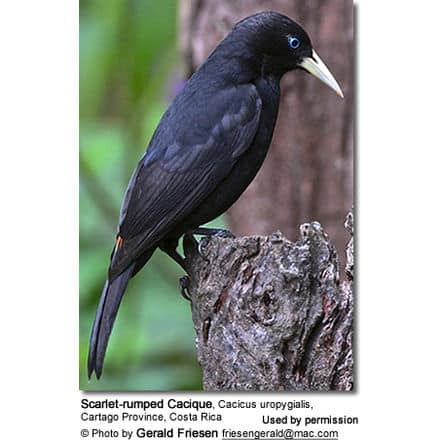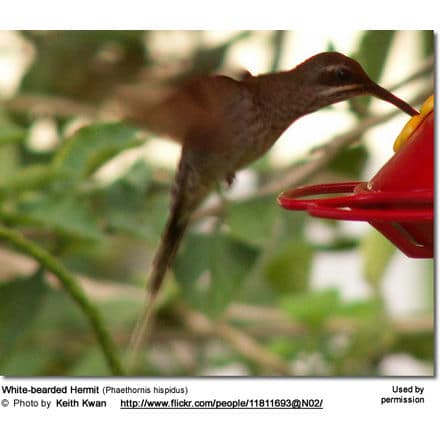Scarlet-rumped Caciques
Cacique Information … Cacique Species Photo Gallery
The Scarlet-rumped Caciques, Cacicus microrhyncus, is a passerine bird in the New World family Icteridae.
As a whole, C. uropygialis is usually called the Scarlet-rumped Cacique. However, it is often split into two species, in which case this name is limited to Cacicus (uropygialis) microrhynchus (with subspecies pacificus), while the nominate subspecies, C. u. uropygialis, is referred to as the Subtropical Cacique.
The “true” Scarlet-rumped Caciques – then Cacicus microrhynchus – may also be split further; the Pacific populations have been proposed as the Pacific Cacique (Cacicus pacificus). The AOU considers it likely that at least two species are involved but points out that no dedicated analysis of the data at hand has been published. It therefore does not formally recognize the split at present.
Distribution / Range
The Scarlet-rumped Caciques breeds from eastern Honduras to Panama in the Pacific lowlands of South America from western Colombia south to Ecuador, and the lower reaches of the northern Andes. There are several subspecies, some of which have been proposed for elevation to full species status.
The Scarlet-rumped and Pacific Caciques are birds associated with humid lowland primary forests or old secondary forests at up to 1000 m (3,300 ft) ASL. The Scarlet-rumped Cacique is found from Honduras, through Nicaragua and Costa Rica, to Panama (except Darién), while the Pacific Cacique is found from eastern Panama (Darién), through western Colombia, to western Ecuador.
Subtropical Caciques occur at higher altitudes; they have been recorded as high as 2,450 m (8,000 ft) ASL and are found along the eastern slopes of the Andes at altitudes of 1000-2300 m (3300-7500 ft) in submontane or cloud forest, ranging from Venezuela, through Colombia and Ecuador, to Peru, with an isolated population in the Serranía del Perijá. Their habitat has a lower canopy than that of their lowland relatives, dominated by trees of little more than 15-20 (50-65 ft) height, for example, oaks (Quercus). Epiphytes, hemiepiphytes like Coussapoa (Urticaceae), and a usually dense understory with tree ferns, Ericaceae, etc. are also typical habitat features.
Breeding / Nesting
Unlike some other caciques they are not usually colonial breeders; like them, they have a bag-shaped nest. It is built about c. 3.5-30 m (10-100 ft) above ground, in a tree which usually also contains an active wasp nest. The bird’s nest is 36-64 cm (14-25 in) long, widens at the base, and is suspended from the end of a branch.
The normal clutch is two dark-blotched white eggs. The male will assist in feeding the young but does not incubate.
Description
The Scarlet-rumped Caciques has sexual dimorphism like many Icteridae, though it mainly concerns size in this species. Males are 23 cm (9 in) long and weigh 68 g (2.4 oz), while the female is 20 cm (8 in) long and weighs 53 g (1.9 oz); they follow Bergmann’s Rule, with the Subtropical Caciques of the cooler uplands being larger.
This cacique is a slim long-winged bird, with a relatively short tail, blue eyes, and a pale yellow pointed bill. It has mainly black plumage, apart from a scarlet patch on the lower back and upper rump.
The female is smaller and a duller black than the male, and the juvenile bird has a brownish tone to the plumage and a brownish-orange rump.
Call / Vocalizations
The song of these birds is a pleasant wheee-whee-whee-whee-wheet, but the Pacific Cacique has a descending melancholy wheeo-wheeo-wheeo-wheeo. The calls birds give to members differ between the three groups: those of the Subtropical Caciques sound rather untypical for icterids and more like the chatter of an excited Great Thrush (Turdus fuscater). The Scarlet-rumped Cacique in the narrowest sense has a burry pleeo; the Pacific Cacique has a sweeter keeo or a shree.
Diet / Feeding
The Scarlet-rumped Caciques forage through the canopy in small flocks. It feeds on large insects, spiders, and small vertebrates, but will also take some fruit. It often forms a mixed-species feeding flock with similarly robust and rowdy songbirds, such as other icterids, Black-faced Grosbeaks (Caryothraustes poliogaster), or American jays. Such noisy flocks may also attract trogons or flycatchers.
Status
The IUCN conservation status of Least Concern applies to the taxon in the broad sense. Both the Scarlet-rumped (in the narrower sense) and the Pacific Cacique are widespread and locally common. The Subtropical Cacique is generally uncommon to rare, but due to its extensive range unlikely to be seriously threatened.
Copyright: Wikipedia. This article is licensed under the GNU Free Documentation License. It uses material from Wikipedia.org … Additional information and photos added by Avianweb.
Please Note: The articles or images on this page are the sole property of the authors or photographers. Please contact them directly with respect to any copyright or licensing questions. Thank you.




